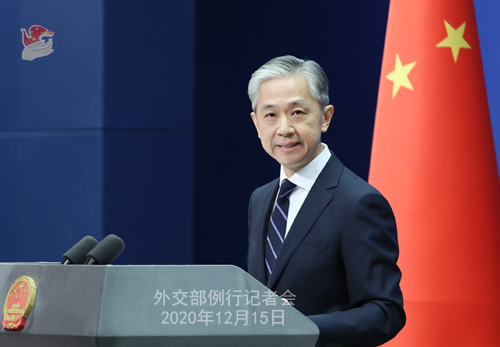
Süddeutsche Zeitung:The Center for Global Policy published this morning a report suggesting that every year more than 500,000 people in Xinjiang are forced to pick cotton. The report claims that the majority of cotton grown in China is harvested by forced labor. Could you please comment?
Wang Wenbin: We already stated China's position on the so-called "forced labor" issue on multiple occasions. According to laws including Labor Law, Labor Contract Law, and relevant administrative regulations, Chinese citizens sign voluntarily contracts with their employers on the basis of equality and consensus and get due payment. There is no "forced labor" alleged by some with ulterior motives.
Helping people of all ethnic groups secure stable employment is entirely different from "forced labor". According to the Forced Labor Convention of the International Labor Organization, the term "forced labor" means all work or service which is exacted from any person under the menace of any penalty and for which the said person has not offered himself voluntarily". All ethnic groups in Xinjiang choose their occupations according to their own will and sign employment contracts of their own volition in accordance with law on the basis of equality. They will not be discriminated against because of their ethnicity, gender or religious belief. Governments at all levels in Xinjiang fully respect the will of ethnic minority people in their employment choices and provide training for those who wish to improve the skills needed for employment. According to the Investigation Report on Employment of Ethnic Minorities in Xinjiang, 86.5% of the labor force in four surveyed villages are willing to work outside their hometown, which indicates that the ethnic minorities have a strong willingness of voluntarily going out for jobs. By the end of 2019, a total of 2.9232 million people in Xinjiang had been lifted out of poverty, and the incidence of poverty had fallen from 19.4 percent in 2014 to 1.24 percent.
This report you talked about mentioned the so-called photos of "reeducation centers". Some western media absurdly take any walled-building in Xinjiang as "detention center", but the fact is they are all civil institutions. For instance, the so-called "detention centers" in Tulufan are actually the buildings of the local administrative offices, and the "detention centers" in Kashi are actually local high school campuses, all of which are marked out on Google and Baidu maps. You all can check on them.
I noted that the author of this report is Adrian Zenz. The media has repeatedly disclosed that he is a member of a far-right organization founded by the U.S. government and a key member of anti-China institute set up by the U.S. intelligence agency, making a living from fabricating rumors and slanders against China. His so-called report does not have the slightest of credibility and academic integrity in it. I'd like to name some of his tricks to cook up falsehood for your reference.
First, data fraud. In his report on so-called forced sterilization, Adrian Zenz claimed that "in 2018, 80 percent of all net added IUD placements in China were performed in Xinjiang", but the fact is that Xinjiang accounted for only 8.7 percent of the country's new IUD placements in 2018, according to China's National Health Commission.
Second, fabrications out of thin air. Adrian Zenz fabricated a so-called "Karakax (Moyu) List" where the most frequently cited internment reason was a violation of birth control. In fact, most of the people in the list are local residents of the Moyu county, who have been leading a normal life there. Only a very small number of people who have been affected by religious extremism and committed minor crimes have received vocational education and training in accordance with the law.
Third, groundless speculations. Adrian Zens alleged that women of ethnic minorities in Xinjiang receive excessively frequent checks and tried to use it as the evidence to prove that the Chinese government imposed forced sterilization on Uighur women who have given birth to a child. But there was no evidence in his report that women were forced by the government to use IUDs after having a child. His so-called conclusion is nothing but the product of his own wild conjecture.
Fourth, numbers game. Adrian Zens claimed that the natural population growth of Han ethnicity in Gulbagh Residential District is nearly eight times higher than that of Hotan County in 2018, using this as an example to lash out at the so-called policy of "Han settler colonialism". The comparison of natural population growth rate between a residential district and a county is of no academic value demographically. Speaking of facts, if we compare the changes of Han population and Uyghur population in Hotan in 2017 and 2018, we can find that the total of Han population is decreasing, while that of Uyghur population is increasing. Adrian Zens' allegation that the Chinese government is doubling down on a policy of "Han settler colonialism" is a complete lie without any factual basis.
We hope that friends from the media and people in other sectors can distinguish right from wrong, respect the facts, and do not be deceived by people like Adrian Zens, who use every possible means to make falsehood in academic research just to serve anti-China purposes.
